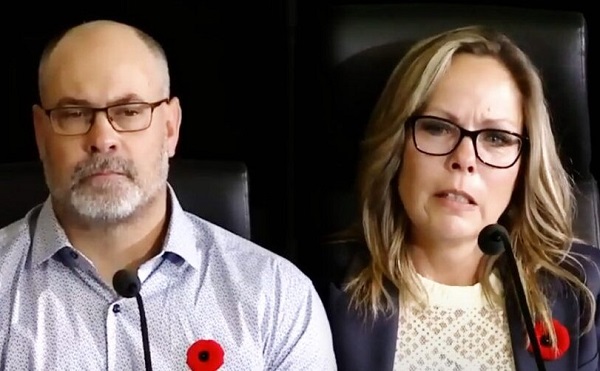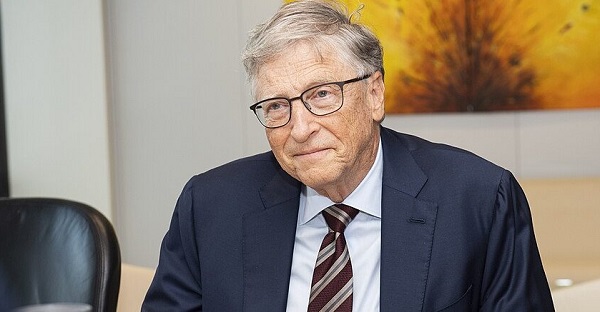Brownstone Institute
The Deception Is Getting More Brazen

One of the most disappointing aspects of the COVID pandemic has been the willingness of adults to impose untested restrictions and policies on young children, while ignoring any potential negative impacts to their mandates.
Without pushback from the media, supposed “experts” have recommended school closures, remote learning, forced masking and now, universal vaccination for children ages 6 months-<5 years.
The lack of data or evidence suggesting a benefit to these policies has seemingly never been a hindrance to their recommendations. In fact, it often feels as if they dare others to point out that their policy mandates are not based on any high quality research.
Instead of engaging with the mountains of substantive criticism of their methodology or the discrediting flaws of the “studies” they reference, they simply revert back to appeals to authority.
They’re right, because they say so.
This phenomenon has often been applied to “interventions” forced on children, but it’s also easily applicable to the debate over the origins of COVID.
For much of the first year of the pandemic, “experts” and the “fact checking” media colluded to ensure that discussion of the lab leak theory would be censored and users banned for suggesting it as a possibility.
Only after the approved political sources deemed it acceptable to discuss did social media companies relent.
Except one of the world’s supposed leading “experts,” the head of the World Health Organization, has apparently been telling people privately that he believes the lab leak is the most likely explanation for the origin of the virus.
Of course, none involved in the expert approved censorship will apologize or demand changes as a result.
Because whatever they say is right. No matter how many times they’re wrong first.
You’d think that being caught lying, misrepresenting evidence or flouting their own rules would be enough to instill a level of shame in politicians and their ideological allies, but the recent Supreme Court decision overturning Roe v. Wade shows there truly is no limit to the hypocrisy they’re capable of.
It’s important to shine a light on these three issues — the lying, the hypocrisy and the purposeful misrepresentations. Holding the “experts” and politicians accountable is the only chance to stop the madness of COVID policy from becoming permanent.
More Embarrassments for the FDA & CDC
Possibly the most important thing to know about the FDA authorizing vaccinations for young children is that there is virtually no evidence to support their decision.
When you review the FDA documents, it’s shocking to see how little data they used to make their decision and how ineffective the trials proved to be.
Unsurprisingly, the CDC joined in by misrepresenting the risks of COVID to children.
The CDC has deservedly been at the forefront of the erosion of “expertise,” beginning with their early flip flop on masks. In spring 2020, the CDC recommended against mask wearing by the general public, in line with pre-COVID evidence. By summer 2020, the director of the organization was claiming that masks would provide better protection than vaccines.
They continued to mislead the public on the effectiveness of masks, collaborated with teacher’s unions to keep schools closed and claimed that vaccinated people did not “carry the virus.” Repeatedly, the CDC has shown that they are willing to mislead in order to achieve their policy goals.
But this latest misstep might be their worst yet.
Seemingly out of a desire to justify authorizing vaccinations for young children, the CDC presented misleading data on the risks of COVID.
At a recent meeting of the Advisory on Immunization Practices group, as chronicled in a post by writer Kelley K, the CDC presented a graphic claiming that COVID was a leading cause of death among kids 0-4.

Except this graphic is completely false.
It came from a preprint posted by researchers in the UK, who reviewed mortality data from the National Center for Health Statistics. That dataset includes deaths where COVID was the main contributor as well as those where it was present, but not the underlying cause.
This discrepancy creates a significant issue with accuracy, since the preprint claimed to “only consider Covid-19 as an underlying (and not contributing) cause of death”.
As Kelley points out, there is a noticeable difference between the NCHS statistics and the CDC’s own “WONDER” database, which delineates between contributing and underlying causes.
NCHS, which includes incidental COVID deaths, shows that 1,433 children died with COVID, but the WONDER database shows 1,088 deaths from COVID. That’s a 24% difference and would dramatically alter the graphic.
They used COVID data that included deaths with COVID and compared it to data that includes deaths from an illness.
It’s completely discrediting.
Even worse, the misleading graphic represents COVID deaths cumulatively and compares it to annualized data. Simply, they took two years of COVID related mortality and compared it to one year of data for all other causes.
Kelley re-ran the data using the correct comparisons, which significantly altered the outcome.
While the CDC rankings claimed that COVID was the 4th leading cause of death for children under the age of 1, the corrected annualized ranking was 9th, after using exclusively underlying cause data.
Similarly, the NCHS data used in the preprint and by the CDC claimed 124 deaths in that age group, but COVID was the underlying cause in only 79 deaths.
Rankings for childhood mortality are also overly simplistic, since even the “leading” causes of death pale in comparison to accidents, which caused ~25x more annualized deaths than COVID.
But the worst part about this is that the CDC likely knew that the data they were presenting was wrong and dangerously misleading. And they used it anyway.
They were so desperate to justify their desire to vaccinate young children that they were willing to use inaccurate information and comparisons to do so.
They knew that the media and influential “experts” around the internet would pick up on the graphic, creating unnecessary fear amongst parents and higher demand for the vaccines. And of course, they were right; CNN’s Leana Wen immediately shared the slides:
Instead of accurately informing the public and allowing parents to make a risk-benefit calculation, the CDC is essentially trying to coerce behavior through fear.
Even better, the lead researcher posted on Twitter that they were aware of the issues and would be making corrections.
But of course, it’s too late. The data has now been spread far and wide; the CDC and their allies did their damage. The vaccines were authorized regardless and many parents will make the decision to vaccinate their children based on misrepresented information.
It’s yet another episode in the depressing saga of experts disgracing themselves to achieve their goals and undercutting the public’s trust in the process.
The Lab Leak
A new story from the Daily Mail reports that World Health Organization Director-General Tedros Adhanom Ghebreyesus privately admits that he believes that the COVID-19 pandemic originated in a Wuhan laboratory.
Tedros apparently made the remarks to a prominent European politician that a “catastrophic accident” was the “most likely explanation” for the beginning of the pandemic.
The WHO in early 2021 started an investigation into the origins of the pandemic, which concluded that the lab leak hypothesis was “extremely unlikely.” However, the researcher who led that investigation claimed that China “pressured” the team to “dismiss” the lab leak theory.
Scientific journal The Lancet attempted an investigation, which was disbanded over conflicts of interest. Eco Health Alliance head Peter Daszak failed to disclose his close ties to the Wuhan lab, resulting in criticism of the committee’s objectivity.
While privately Tedros is now seemingly admitting that the lab leak is the most likely origin, the official position of the WHO is that “all hypothesis” are still possible.
It’s extremely unlikely that they will ever change their official, public statements given China’s importance to the organization.
In early 2020, for example, China contributed an additional $30 million to the WHOin what was described as a “political power move” to “boost its superficial credentials.”
The true origins of the pandemic are obviously an extremely important issue not just for China and the WHO, but the global political landscape. Beyond officially determining where the virus came from, if it is conclusively determined to have resulted from a lab leak, it would be a crushing blow to “experts” like Dr. Anthony Fauci who tried repeatedly to shut down the theory.
“The science” has been repeatedly referenced by media outlets, public health authorities and politicians as an immutable set of beliefs that are unassailable and infallible.
If a deadly global pandemic that has resulted in the deaths of millions of people, destroyed economies, increased poverty and furthered educational deterioration started in a research lab, it could mark a devastating shift in the public’s view of “science.”
What’s most infuriating about Tedros finally (and privately) giving credence to the lab leak is that for much of 2020, proponents of the hypothesis were decried as “conspiracy theorists.”
The Washington Post famously published an article calling it a “debunked” conspiracy theory and were forced to issue a humiliating correction afterwards.
Media outlets like the Post never had any justification to call the lab leak a “debunked” conspiracy, but it’s obvious they felt safe in describing at as such because it was promoted by the wrong people. Tom Cotton, a Republican Senator, had advanced the hypothesis, therefore it must be “debunked” because Cotton belongs to the wrong ideology.
That myopic, politically motivated thinking has been a common function of most major media outlets who are often desperate to declare their allegiance to the correct set of approved liberal opinions.
Social media companies like Facebook used the media and WHO as authoritative sources of information and as a result, banned users from even discussing the lab leak.
Only in mid-2021 did Facebook reverse course after admitting it was not “debunked.”
This story contains all the infuriating elements of COVID discussion – “experts” lying to the public and bowing to political pressure from China, a fake consensus of opinion created by the media, and social media outlets protecting “science” by censoring opposing viewpoints.
While China’s opposition to an actual investigation will likely prevent any conclusive findings, it’s notable that the head of the WHO admits privately that the “conspiracy theorists” were probably right all along.
Vaccine Mandate Hypocrisy
The Supreme Court decision in Dobbs v. Jackson Women’s Health Organization overturning Roe v. Wade has dominated the news cycle since the opinion was released Friday.
Reactions from the pro-abortion side have been ranged from deliberately misleading to woefully inaccurate to offensive, with one comedian labeling half the country as “terrorists.”
But yet another type of hypocrisy has emerged from supposed public health “experts” and politicians.
Best exemplified by U.S. Surgeon General Vivek Murthy and Canadian Prime Minister Justin Trudeau, it’s yet another indicator of how the response to Roe v. Wade is about nothing more than maintaining allegiance to the correct political ideology, intellectual consistency be damned.
In 2021, President Joe Biden attempted to mandate COVID vaccination for millions of workers throughout the United States by appealing to OSHA authority. Any employee who worked for a company with more than 100 employees would have had their freedom of choice removed by being forced to take a vaccine that does nothing to protect the safety of others.
The mandate was ultimately deemed to be illegal, but the attempt was celebrated by public health “experts” and many politicians as the correct decision, regardless of its impact on bodily autonomy.
Back in November of 2021, Murthy defended the government mandating a private health decision by saying: “It’s a necessary step to accelerate our pathway out of the pandemic.” He also referred to it as entirely “appropriate:”
“The president and the administration wouldn’t have put these requirements in place if they didn’t think they were appropriate and necessary,” Murthy told host Martha Raddatz on ABC’s “This Week.” “And the administration is certainly prepared to defend them.”
Murthy believes that when it comes to COVID vaccination, the “essential principle of maintaining an individual’s autonomy and control over their health decisions” is null and void.
Unsurprisingly, he had the exact opposite reaction to the Supreme Court’s decision:
It’s amazing how flexible the “essential principle” of “individual autonomy and control over their health decisions” apparently is.
When it suits Murthy’s political needs, he’s a staunch defender of individual choice. When he wants to mandate control over other’s bodies and personal health decisions, choice is a meaningless, easily dismissed concept.
Justin Trudeau exemplifies the same remarkable lack of shame.

Less than a year ago, Trudeau mandated vaccines for anyone attempting to travel by plane or train across Canada, as well as for all “federally-regulated” workers.
This decision, of course, removed bodily autonomy and choice for millions who need to travel or didn’t want to lose their government jobs.
Undeterred by the abject hypocrisy, Trudeau on Friday declared that “no government, politician, or man should tell a woman what she can and cannot do with her body.”
It’s hard to imagine a more blatant example of political posturing and virtue signaling.
Trudeau, who is a man, politician, and a representative of the government, told many women in Canada exactly what they had to do with their body.
Get vaccinated or lose your job and stay home.
He had no problem removing the “right to choose” when it suited his needs. Only now when he has an opportunity to signal his ideological virtue is he a champion of individual liberty.
It’s nothing new for politicians and public health authorities to be hypocritical. But their ability to blatantly disregard the principles of bodily autonomy and personal control over health decisions just a few months ago means it’s impossible to take them seriously now.
It’s almost assuredly too much to ask “experts” and politicians to be intellectually consistent, but it’s yet another example of why trust in institutions and those that run them continues to deteriorate.
It’s all part of the same depressing pattern. Experts and politicians are willing to lie or purposefully withhold information to achieve their goals.
They mislead and contradict their previous statements, knowing that the media will protect the hypocrisy and misrepresentations.
The FDA buries the data behind the authorization in documents they know no one will read.
The head of the most powerful international health body hides his true feelings to protect China and his financial partners.
It’s hard to see how this gets fixed without these individuals and the organizations they lead coming to terms with their mistakes, apologizing and changing course.
I wouldn’t hold your breath.
After all, Joe Biden already wants to give them more money for the next pandemic.
Reposted from the author’s Substack
Brownstone Institute
Bizarre Decisions about Nicotine Pouches Lead to the Wrong Products on Shelves

From the Brownstone Institute
A walk through a dozen convenience stores in Montgomery County, Pennsylvania, says a lot about how US nicotine policy actually works. Only about one in eight nicotine-pouch products for sale is legal. The rest are unauthorized—but they’re not all the same. Some are brightly branded, with uncertain ingredients, not approved by any Western regulator, and clearly aimed at impulse buyers. Others—like Sweden’s NOAT—are the opposite: muted, well-made, adult-oriented, and already approved for sale in Europe.
Yet in the United States, NOAT has been told to stop selling. In September 2025, the Food and Drug Administration (FDA) issued the company a warning letter for offering nicotine pouches without marketing authorization. That might make sense if the products were dangerous, but they appear to be among the safest on the market: mild flavors, low nicotine levels, and recyclable paper packaging. In Europe, regulators consider them acceptable. In America, they’re banned. The decision looks, at best, strange—and possibly arbitrary.
What the Market Shows
My October 2025 audit was straightforward. I visited twelve stores and recorded every distinct pouch product visible for sale at the counter. If the item matched one of the twenty ZYN products that the FDA authorized in January, it was counted as legal. Everything else was counted as illegal.
Two of the stores told me they had recently received FDA letters and had already removed most illegal stock. The other ten stores were still dominated by unauthorized products—more than 93 percent of what was on display. Across all twelve locations, about 12 percent of products were legal ZYN, and about 88 percent were not.
The illegal share wasn’t uniform. Many of the unauthorized products were clearly high-nicotine imports with flashy names like Loop, Velo, and Zimo. These products may be fine, but some are probably high in contaminants, and a few often with very high nicotine levels. Others were subdued, plainly meant for adult users. NOAT was a good example of that second group: simple packaging, oat-based filler, restrained flavoring, and branding that makes no effort to look “cool.” It’s the kind of product any regulator serious about harm reduction would welcome.
Enforcement Works
To the FDA’s credit, enforcement does make a difference. The two stores that received official letters quickly pulled their illegal stock. That mirrors the agency’s broader efforts this year: new import alerts to detain unauthorized tobacco products at the border (see also Import Alert 98-06), and hundreds of warning letters to retailers, importers, and distributors.
But effective enforcement can’t solve a supply problem. The list of legal nicotine-pouch products is still extremely short—only a narrow range of ZYN items. Adults who want more variety, or stores that want to meet that demand, inevitably turn to gray-market suppliers. The more limited the legal catalog, the more the illegal market thrives.
Why the NOAT Decision Appears Bizarre
The FDA’s own actions make the situation hard to explain. In January 2025, it authorized twenty ZYN products after finding that they contained far fewer harmful chemicals than cigarettes and could help adult smokers switch. That was progress. But nine months later, the FDA has approved nothing else—while sending a warning letter to NOAT, arguably the least youth-oriented pouch line in the world.
The outcome is bad for legal sellers and public health. ZYN is legal; a handful of clearly risky, high-nicotine imports continue to circulate; and a mild, adult-market brand that meets European safety and labeling rules is banned. Officially, NOAT’s problem is procedural—it lacks a marketing order. But in practical terms, the FDA is punishing the very design choices it claims to value: simplicity, low appeal to minors, and clean ingredients.
This approach also ignores the differences in actual risk. Studies consistently show that nicotine pouches have far fewer toxins than cigarettes and far less variability than many vapes. The biggest pouch concerns are uneven nicotine levels and occasional traces of tobacco-specific nitrosamines, depending on manufacturing quality. The serious contamination issues—heavy metals and inconsistent dosage—belong mostly to disposable vapes, particularly the flood of unregulated imports from China. Treating all “unauthorized” products as equally bad blurs those distinctions and undermines proportional enforcement.
A Better Balance: Enforce Upstream, Widen the Legal Path
My small Montgomery County survey suggests a simple formula for improvement.
First, keep enforcement targeted and focused on suppliers, not just clerks. Warning letters clearly change behavior at the store level, but the biggest impact will come from auditing distributors and importers, and stopping bad shipments before they reach retail shelves.
Second, make compliance easy. A single-page list of authorized nicotine-pouch products—currently the twenty approved ZYN items—should be posted in every store and attached to distributor invoices. Point-of-sale systems can block barcodes for anything not on the list, and retailers could affirm, once a year, that they stock only approved items.
Third, widen the legal lane. The FDA launched a pilot program in September 2025 to speed review of new pouch applications. That program should spell out exactly what evidence is needed—chemical data, toxicology, nicotine release rates, and behavioral studies—and make timely decisions. If products like NOAT meet those standards, they should be authorized quickly. Legal competition among adult-oriented brands will crowd out the sketchy imports far faster than enforcement alone.
The Bottom Line
Enforcement matters, and the data show it works—where it happens. But the legal market is too narrow to protect consumers or encourage innovation. The current regime leaves a few ZYN products as lonely legal islands in a sea of gray-market pouches that range from sensible to reckless.
The FDA’s treatment of NOAT stands out as a case study in inconsistency: a quiet, adult-focused brand approved in Europe yet effectively banned in the US, while flashier and riskier options continue to slip through. That’s not a public-health victory; it’s a missed opportunity.
If the goal is to help adult smokers move to lower-risk products while keeping youth use low, the path forward is clear: enforce smartly, make compliance easy, and give good products a fair shot. Right now, we’re doing the first part well—but failing at the second and third. It’s time to fix that.
Addictions
The War on Commonsense Nicotine Regulation

From the Brownstone Institute
Cigarettes kill nearly half a million Americans each year. Everyone knows it, including the Food and Drug Administration. Yet while the most lethal nicotine product remains on sale in every gas station, the FDA continues to block or delay far safer alternatives.
Nicotine pouches—small, smokeless packets tucked under the lip—deliver nicotine without burning tobacco. They eliminate the tar, carbon monoxide, and carcinogens that make cigarettes so deadly. The logic of harm reduction couldn’t be clearer: if smokers can get nicotine without smoke, millions of lives could be saved.
Sweden has already proven the point. Through widespread use of snus and nicotine pouches, the country has cut daily smoking to about 5 percent, the lowest rate in Europe. Lung-cancer deaths are less than half the continental average. This “Swedish Experience” shows that when adults are given safer options, they switch voluntarily—no prohibition required.
In the United States, however, the FDA’s tobacco division has turned this logic on its head. Since Congress gave it sweeping authority in 2009, the agency has demanded that every new product undergo a Premarket Tobacco Product Application, or PMTA, proving it is “appropriate for the protection of public health.” That sounds reasonable until you see how the process works.
Manufacturers must spend millions on speculative modeling about how their products might affect every segment of society—smokers, nonsmokers, youth, and future generations—before they can even reach the market. Unsurprisingly, almost all PMTAs have been denied or shelved. Reduced-risk products sit in limbo while Marlboros and Newports remain untouched.
Only this January did the agency relent slightly, authorizing 20 ZYN nicotine-pouch products made by Swedish Match, now owned by Philip Morris. The FDA admitted the obvious: “The data show that these specific products are appropriate for the protection of public health.” The toxic-chemical levels were far lower than in cigarettes, and adult smokers were more likely to switch than teens were to start.
The decision should have been a turning point. Instead, it exposed the double standard. Other pouch makers—especially smaller firms from Sweden and the US, such as NOAT—remain locked out of the legal market even when their products meet the same technical standards.
The FDA’s inaction has created a black market dominated by unregulated imports, many from China. According to my own research, roughly 85 percent of pouches now sold in convenience stores are technically illegal.
The agency claims that this heavy-handed approach protects kids. But youth pouch use in the US remains very low—about 1.5 percent of high-school students according to the latest National Youth Tobacco Survey—while nearly 30 million American adults still smoke. Denying safer products to millions of addicted adults because a tiny fraction of teens might experiment is the opposite of public-health logic.
There’s a better path. The FDA should base its decisions on science, not fear. If a product dramatically reduces exposure to harmful chemicals, meets strict packaging and marketing standards, and enforces Tobacco 21 age verification, it should be allowed on the market. Population-level effects can be monitored afterward through real-world data on switching and youth use. That’s how drug and vaccine regulation already works.
Sweden’s evidence shows the results of a pragmatic approach: a near-smoke-free society achieved through consumer choice, not coercion. The FDA’s own approval of ZYN proves that such products can meet its legal standard for protecting public health. The next step is consistency—apply the same rules to everyone.
Combustion, not nicotine, is the killer. Until the FDA acts on that simple truth, it will keep protecting the cigarette industry it was supposed to regulate.
-

 Daily Caller2 days ago
Daily Caller2 days agoUN Chief Rages Against Dying Of Climate Alarm Light
-

 espionage2 days ago
espionage2 days agoU.S. Charges Three More Chinese Scholars in Wuhan Bio-Smuggling Case, Citing Pattern of Foreign Exploitation in American Research Labs
-

 Business1 day ago
Business1 day agoCarney budget continues misguided ‘Build Canada Homes’ approach
-

 Business2 days ago
Business2 days agoU.S. Supreme Court frosty on Trump’s tariff power as world watches
-

 Business1 day ago
Business1 day agoCarney budget doubles down on Trudeau-era policies
-

 COVID-191 day ago
COVID-191 day agoCrown still working to put Lich and Barber in jail
-

 Business13 hours ago
Business13 hours agoBill Gates Gets Mugged By Reality
-

 Alberta11 hours ago
Alberta11 hours agoAlberta’s number of inactive wells trending downward















